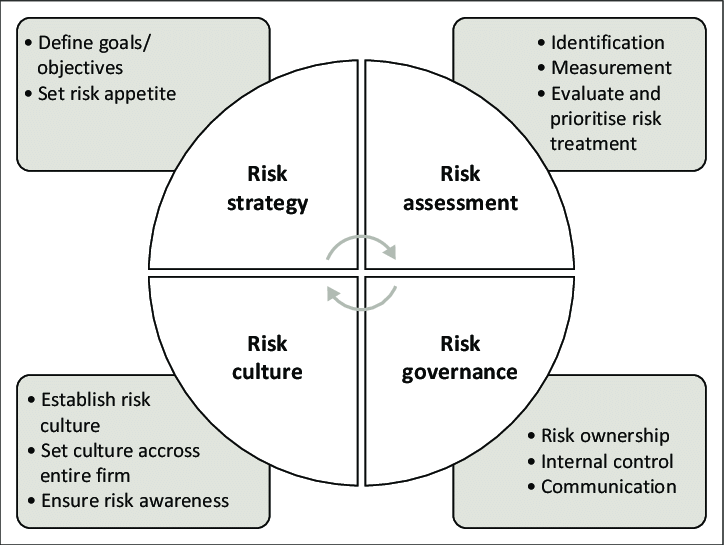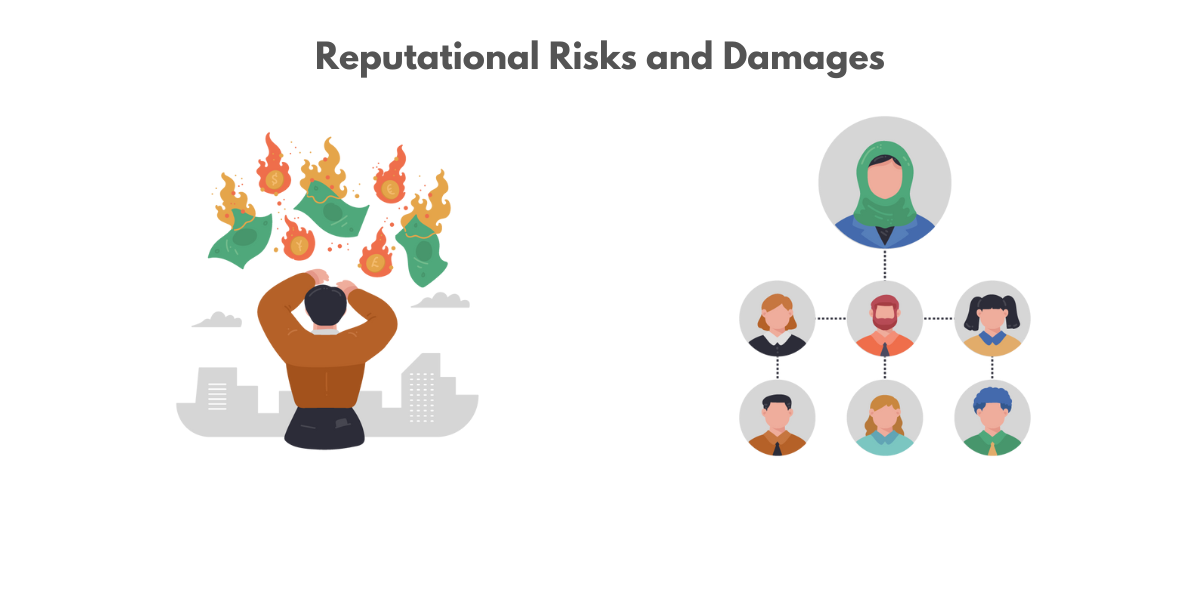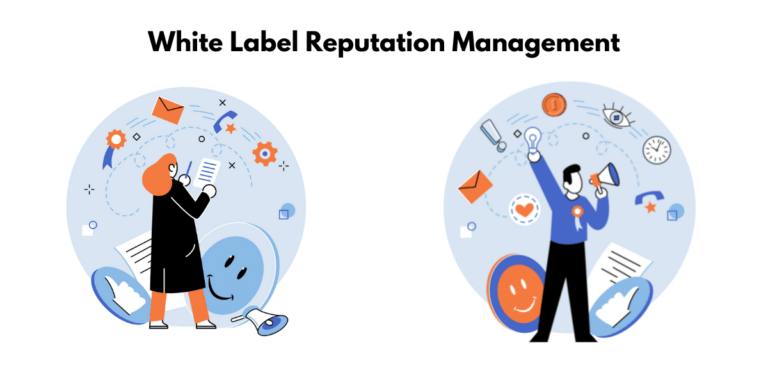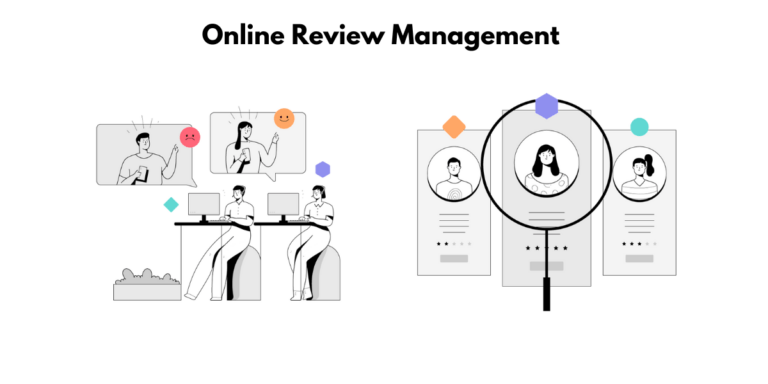Let’s discuss reputational damage
Reputational damage is a term used to describe the harm that can be caused to a company’s reputation.
This can be from the public, the media, or other sources.
There are many ways to prevent and recover from a reputation-damaging event.
Social media or poor employee decisions cause the most common types of reputational damage.
The most significant risk to a corporate reputation is the actions of its employees.
Companies can open themselves up to risks when they do not properly protect their consumers’ data.
A data breach is one way to damage your brand reputation and trust.
If regulatory agencies take privacy notice or the public becomes aware of the poor practices of a company, it can lead to reputational damage.
This damage is usually associated with underperforming companies, overcharging, or practising shady sales tactics.
What are some examples of reputational damage?
There are a few different ways to measure the reputational damage of a company.
One is by looking at the indirect costs, which are not always visible.
Another way is to look at financial market regulatory sanctions and reputational damage.
The reputational damage amount is calculated by multiplying the gross revenues by the days remaining in the contingent period.
The schedule includes various time frames for when a company could be notified, or adverse media reports released but generally ends after 90 days from the coverage start date.
There are a few key things to understand about reputational damage.
First and foremost, companies must avoid any behavior that could lead to such damage.
This includes disclosing any pending criminal proceedings or convictions for a Criminal Offence as defined in the regulations.
Financial damages may be available if reputational damage occurs during the contingent period.
However, this only applies if the company’s brand hurts potential customers.
Additionally, we license our proprietary rights to third parties, and they could cause a defamation claim if they infringe upon our rights or violate the terms of their licensing agreements.
How can reputational damage be prevented?
To prevent reputational damage, monitoring your brand’s online presence and ensuring you are not coming across as controversial or in poor taste is important.
This will help you avoid negative feedback and help your brand maintain its reputation with the public.

What are reputational risks?
Reputational risk is the potential loss of value to an organization due to a negative perception of its reputation.
This can happen when the expectations of shareholders are higher than reality.
For example, if a company is known for its high-quality products but then releases a product that is low quality, this could lead to a decrease in the stock price and damage to the company’s reputation.
Poor workplace performance and conduct are key causes of reputational risk.
Key areas to be aware of include poor workplace operations and conduct, which includes upper management and third parties you work with.
Negative media coverage can also significantly impact an organization’s reputation.
There are a variety of risks that can hurt a company’s reputation.
For example, customer data could be mishandled or breached, CEOs and employees could engage in unethical behavior, or expectations about the company could change.
Companies must understand their shareholders and what they value to protect their reputations.
Why is reputational risk important?
Reputation is an intangible asset that drives a company’s success.
It can be difficult to quantify, but it is something that customers, employees, and investors consider when deciding where to do business.
A good reputation can help an organization attract and retain customers, employees, and investor relations.
Social media can have a significant impact on the public perception of a company.
Negative comments or news stories about a company can spread quickly online and damage its reputation.
This can hurt the company’s bottom line by impacting sales, employee turnover, and investment in the company.
Brand risk is a serious issue for companies.
The potential for negative publicity means companies must know how the public perceives their brands.
Conducting brand reputation management can help uncover where your small business may be at risk and plan steps to mitigate it.
How do you find reputational risk?
There are a few key ways to find reputational risk:
- Internal monitoring – You should have systems to monitor your company for potential issues. This includes social media, complaints, and other public forums.
- External sources – Some organizations collect personal information on businesses and their reputations. You can also use search engines to find articles and news stories about your company.
- Friends and family – Your friends and family members may be the first to notice something wrong with your business’ reputation. They may also be more likely to share negative information about your company online or offline.

What impacts are caused by reputational risk?
There are a few different impacts that can be caused by reputational risk.
It can affect how employees view their workplace and whether or not they want to stay with the company.
Poor workplace operations and conduct can affect your reputation.
This includes how upper management conducts itself and what third parties you work with do.
Reputational risks include reputational risk coverage and other harmful consequences.
For example, if your business is in the public eye and something goes wrong, it could lead to a lot of bad press for your company that could scare away potential customers or partners.
Inadequate quality of services and products can result in a damaged reputation for businesses, such as faulty products that must be recalled or sensitive customer data being mishandled or breached.
Understanding your shareholders is important because they can impact your reputation if they’re unhappy with your actions.
Changing expectations can lead to reputational risk if they’re not met – for instance, if you promise new features that aren’t implemented on time, customers may start going elsewhere.
A business risks its reputation by failing to stay up-to-date with the changing demands of its customers and stakeholder expectations.
This could lead to a decline in revenue and market share, as well as employees leaving the company.
Risk management is integral to protecting one’s reputation.
By being aware of the different risks that your company faces, you can put measures into place to protect yourself from any potential damage.
There are many types of risks, such as operational and compliance risks.
Businesses must be aware of all their risks to protect themselves adequately.
10 samples of reputational risks
Reputational risk is crucial for businesses today, as reputational risks can greatly impact their market value.
Reputational risks include direct actions of the company and its practices, actions of employees and leaders, actions of partners or suppliers, and external factors like customers.
Examples of reputational risks include:
- not complying with regulations
- data breaches
- legal actions
- poor working conditions
- poor quality products and services
- negative social media posts
- partner service interruptions
- negative customer reviews
Understanding these risks and the potential damage they can cause is essential for businesses to protect their reputation and market value.
1. Negative media coverage
Negative media coverage is when reports, stories, or other media outlets reflect a critical or negative view of an individual, company, or organization.
This type of coverage can damage a company’s reputation, as seen in the Uber example.
Media coverage can be classified as negative if it is accusatory, defamatory, critical, or conveys a negative opinion of the individual or company it covers.
Negative media coverage can come in the form of opinion pieces or articles reporting negative events and happenings related to the individual or company.
2. Damage to brand reputation
Damage to brand reputation is any negative circumstance that can diminish an organization’s perceived value, resulting in the following:
- decreased revenues
- failure to meet key business objectives
- loss of market share
- reduced shareholder value
- and in some cases, financial insolvency or bankruptcy
It is often caused by a gap between what a company says and what it is perceived to have done.
It can include anything from regulatory breaches and CEO misbehavior to employee indiscretion, cyber-attacks, damning consumer reviews, or critical social media posts.
Reputational damage can negatively impact a business, including client and employee retention, consumer loyalty, investor trust, and increased hiring and marketing costs.
3. Litigation
Litigation is pursuing a legal claim in court to seek compensation for reputational damage caused by someone’s actions or statements.
It may involve filing a lawsuit to seek damages for slander or libel, which are forms of defamation.
Litigation is going through the court system to resolve a dispute.
It involves filing the appropriate paperwork, appearing in court, and presenting evidence supporting your claim to seek a favorable outcome.

4. Customer loss
Reputational damage can cause customer loss by making customers feel that they have been lied to or treated poorly.
This can lead to losing trust in the organization, resulting in customers taking their business to a competitor.
Additionally, customers may choose to share their dissatisfaction on social media platforms which can further damage the organization’s reputation.
In the worst case, this can lead to a significant financial loss in terms of lost sales and compensation expenses, which may even lead to organizational failure.
5. Loss of confidence
Reputational damage can cause a loss of confidence amongst stakeholders, consumers, and employees, resulting in decreased customer loyalty, investor trust, and employee retention.
This can lead to financial losses as companies spend more money on marketing and PR to rebuild their reputation.
Suppose a company fails to communicate with its stakeholders, halt negative media coverage, or respond quickly and effectively. In that case, they risk suffering even more long-lasting damage to their reputation, which may take years and substantial costs to repair.
6. Increased risk of crime
Increased crime risk is a potential consequence of reputational damage that can have a real and lasting impact on a company.
Companies can suffer significant financial losses to remediate any data breach or other event that damages their reputation and brand, creating an environment more prone to criminal activity.
Companies must remain alert to changes in stakeholder expectations and be aware of the potential risks associated with reputational damage.
7. Decreased profits
Reputational damage can lead to decreased profits due to stakeholders’ negative perceptions of the organization.
Loss of customer loyalty, employee retention, and investor trust can lead to increased costs associated with hiring and marketing.
Additionally, it can take a long time and hard work to rebuild trust, which can further impact profits.
Reputational damage can occur when there is a gap between what a company says and what is perceived to have been done, which can lead stakeholders to be less likely to purchase products or services from the company.
8. Staff turnover
Reputational damage can lead to a decrease in employee retention by making the company appear to be a less desirable place to work.
This can lead to increased costs for hiring as employees may be reluctant to work for a company with a damaged reputation.
In addition, the reputational damage can lead to decreased employee satisfaction and morale, resulting in higher turnover rates as employees seek a more positive work environment.
Finally, trust, essential in any successful relationship between an employer and employee, may be lost due to bad reputations, resulting in staff turnover.

9. Decreased efficiency
Reputational damage can lead to decreased efficiency in a variety of ways.
Firstly, if an organization’s reputation has been damaged, potential customers may be less likely to engage with the organization, leading to decreased revenues and a drop in productivity.
Additionally, employees may be less inclined to work for an organization with a damaged reputation, leading to an increased turnover rate and lower efficiency.
Finally, the reputational damage can also cause a decrease in investor trust, leading to a decrease in the availability of capital and fewer resources to invest in production and efficiency.
10. Increased risk of negative publicity
Negative publicity is any kind of public report or discussion that can damage the reputation of a business or organization.
This could include negative product reviews, data breaches, public posts on social media, negative local news stories, product recalls, workplace accidents, negative employer ratings, unfair working environments, and more.
Negative publicity can have lasting effects, as it can cause people to lose trust in an organization and even lead to boycotts.
What are the effects of reputational damage?
Reputational damage is a serious issue for organizations. It can be caused by many factors but often results from how an organization responds to disruptions.
This can include anything from natural disasters to data breaches.
If customers feel they have been lied to or their needs haven’t been considered, they will likely take their business elsewhere.
This can lead to a financial loss and a reputation for the company.
Reputational damage can significantly impact an organization, leading to financial losses from a loss of sales and services.
In addition, the reputational damage can adversely affect online review platforms, with potential customers seeing a negative comment and deciding not to do business with the company.
Organizations should have staff trained in damage-prevention methods to mitigate these risks and be honest with their stakeholders about potential problems.
This will help build trust between the company and its stakeholders.
Lower stock prices
When a company experiences reputational damage, its share price often hits.
For example, Capital One experienced a 6% drop in share price and a large drop in reputation after the breach was announced.
Investors are concerned about longer-term reputational damage, which could cost the company money.
Cyber risk can have a significant and sustained impact on shareholder value.
Pentland Analytics reports that some companies saw their market value drop after a cyber incident by 25%.
Some companies lost 25% of their market value for one year following a ransomware attack.
Diminished brand value
One of the potential consequences of a data breach is diminished brand value.
This can happen when customers or other stakeholders lose trust in your company because of its inability to protect their information.
The effects of reputational damage can vary depending on whether the cause was your fault.
If the breach was caused by negligence, you could expect a much more severe reaction from your stakeholders.
However, if an outside attacker caused the breach, you may be able to mitigate some of the damage by being transparent and reactive.
Reacting quickly and showing accountability will help stop any negative flow from becoming a major problem for your company’s reputation.
It is also important to educate your employees and other stakeholders about how to handle sensitive information.
This will make them less likely to fall victim to phishing attacks or malicious activities.
Cyber insurance is a good way to protect your business from reputational damage.
In addition, advanced threat analytic tools will help you react accordingly when disaster strikes.
Finally, having a task force trained as the first responders can help with bad cyber attacks.
Reputational damage is not necessarily bad and may also have a positive effect.
Increased regulatory scrutiny
Companies facing increased regulatory scrutiny are also exposed to additional risks.
These risks can result in financial penalties, a tarnished reputation, or criminal charges.
Reputational risk can have long-term effects on a company.
In some cases, it can take years for gross revenue to be restored to the pre-notification or first adverse report date.
The ICCA lists the effects of reputational damage, including losing qualified new employees and retaining existing employees.
This could have a material adverse effect on their financial condition and the results of operations.
Brands could suffer reputational damage in some cases if they failed to choose appropriate licensees.
Brands can also take steps like licensing their trademarks or copyrighted material to third parties, which will help them avoid bad reputation.

How is reputational damage measured?
Reputational damage is an intangible and difficult-to-quantify concept that can be measured in various ways.
A common metric for measuring reputation damage is the number of “downvotes” a webpage has received on social media or the number of negative comments posted.
What are some steps that should be taken if reputational damage does occur?
Reputational damage can be a serious issue for businesses. It can impact everything from employee morale to customer loyalty and stock prices.
The Board of Directors is typically the best place to start when managing reputational risk.
Other strategies include conducting a high-level review of all operations, taking timeouts during crises, and factoring reputation risk into business planning and strategy.
Doing so can help ensure your company is better prepared to handle potential reputational risks.
When a company experiences reputational damage, the first step is to communicate effectively.
This includes being honest and open with stakeholders, taking ownership of the issue, and communicating a plan of action. It’s also important to have a culture of ethics and compliance.
Leaders must set an example by following the company’s policies and procedures and escalating issues when necessary.
Additionally, it’s crucial to focus on improving stakeholder experiences.
This will show that the company is committed to addressing the issue and is taking steps to improve.
Acknowledge the problem
When a company experiences a reputational crisis, it is first important to acknowledge the problem.
This will allow the PR team to start creating messaging about the incident.
It is also important to be transparent with consumers, which can help mitigate the damage to the company’s reputation.
Take corrective action
If your company suffers a data breach, it is important to take corrective action immediately. This includes:
- Identify the expectations of your stakeholders.
- To ensure accuracy, your information should come from various sources – surveys, polls, and interviews.
- This will help you understand how the breach has affected them and what message they want to see from you.
- Brand reputation and image are important aspects that must be addressed when a cyberattack occurs.
A data breach can damage a brand’s reputation, even if the data is not personally identifiable. The response to a data breach can make or break an organization’s reputation for good or worse.
Monitor the situation
To protect and preserve its reputation, a company must be proactive in monitoring the environment that surrounds it.
This includes regularly surveying key stakeholders to see how they prioritize the company, tracking any shifts in public opinion, and identifying new trends that could affect its business.
Additionally, keeping an eye on organizations that could impact the company’s reputation is important.
For example, NGOs or online groups can easily damage a company’s image if their actions go unchecked.
If a company’s reputation takes a hit, it must immediately engage with environmental activists, groups concerned about wages and labor practices, consumers’ rights groups, globalization foes, and animals’ rights groups.
This will help identify potential issues before they become too damaging.
Companies must take prompt action to mitigate reputational damage in today’s 24/7 media climate, where news can spread quickly and easily.




![13 [Best] Brand Monitoring Tools and Software to Monitor Your Brands Growth](https://www.profilerankings.com/wp-content/uploads/2023/05/brand-monitoring-tools-768x384.png)